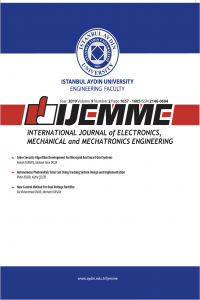Performance Evaluation for MIPv6 IN Pure IPv6 Networks vs. 6 TO 4 IP Mechanism Networks using OPNET
Performance Evaluation for MIPv6 IN Pure IPv6 Networks vs. 6 TO 4 IP Mechanism Networks using OPNET
IPv6, MIPv6, 6 to 4 IP mechanism, IPv4 OPNET,
___
- R. Hinden, S. Deering, "IP Version 6 Addressing Architecture", IETF, RFC 4291 , February 2006, available at https://tools.ietf.org/html/rfc4291, last accessed date :25/12/2015.
- J. Davies ,”Understanding IPv6”,Microsoft Press; 3 edition, June, 2012.
- Abdulkader Omar Alwer ,” The Migration from Protocol IPv4 to IPv6 Mechanism , implementation & Cost” , Alba'ath University Journal, Syria,2007 available online : http://178.253.94.33/magazine/folders/resear ches/detail_id.php?newsid=815 last accessed date :25/12/2015.
- A.Ahmed , A. Mustafa, G. Ibrahim, “Performance Evaluation of IPv4 Vs Ipv6 and Tunnelling Techniques Using Optimized Network Engineering Tools (OPNET)” , IOSR Journal of Computer Engineering (IOSR-JCE); Volume 17, Issue 1, Ver. IV (Jan – Feb. 2015), PP 72-75.2007 available online :http://www.iosrjournals.org/iosr jce/papers/Vol17-issue1/Version- 4/M017147275.pdf.
- Oliveira L., Amaral A., de Sousa, A.F., "Mobility in IPv4–IPv6 Transition Scenarios”, 4th Conferência de Telecomunicações (ConfTELE), Aveiro, Portugal, June 2003. available online: http://www.av.it.pt/asou/papers/oliveiraConf Tele03.pdf.
- C. Perkins,D. Johnson, J. Arkko, “Mobility Support in IPv6” ,IETF, RFC 6275 , July 2011, available at https://tools.ietf.org/html/rfc6275 , last accessed date :25/12/2015.
- R .Kodli, C.Perkins ," Mobile Internetworking with IPv6" ,Wiley ,New Jersey, USA, July 2007, ISBN: 978-0-471-68165-6.
- E. Nordmark , R. Gilligan , “ Basic Transition Mechanisms for IPv6 Hosts and Routers”, IETF, RFC 4213 , October 2005, available at https://tools.ietf.org/html/rfc4213,last accessed date :25/12/2015.
- B. Carpenter , K. Moore ,” Connection of IPv6 Domains via IPv4 Clouds” , IETF, RFC 3056 , February 2001 , available at https://tools.ietf.org/html/rfc3056 , last accessed date :25/12/2015. http://www.internettrafficreport.com/30day.htm.
- R.Blum,”Network performance open source toolkit: Using Netperf, tcptrace, NIST Net, and SSFNet”Wiley, 2003.
- ISSN: 2146-0604
- Başlangıç: 2011
- Yayıncı: İstanbul Aydın Üniversitesi
Ankith Reddy PAMULAPARTHY, Robert C. CREESE, Hota V. GANGARAO, Majid JARIDI
Discharge Coefficient of Sharp-Crested Trapezoidal Labyrinth Weirs
Performance Evaluation for MIPv6 IN Pure IPv6 Networks vs. 6 TO 4 IP Mechanism Networks using OPNET
New Technologies for Modelling in Agricultural Engineering Education
Comparison of Sinusoidal and Space Vector PWM Control Techniques for Three-Level Inverter Drives
